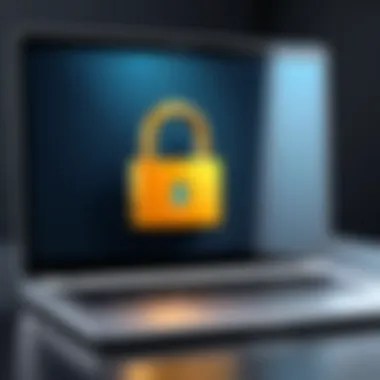A Comprehensive Guide to Setting Up Parental Controls on Your Laptop
Overview of Cyber Security Threats
Online security threats come in various forms, ranging from insidious malware to sophisticated phishing scams. Malware comprises malicious software designed to infiltrate systems and steal sensitive data. Phishing involves deceptive emails or websites that trick individuals into revealing personal information. Ransomware is a type of malware that encrypts files, demanding a ransom for decryption. Statistics reveal a surge in cyber attacks, highlighting the critical need for robust security measures. Numerous real-life examples underscore the devastating impact of security breaches, emphasizing the urgency of safeguarding digital assets.
Best Practices for Online Security
Ensuring robust online security begins with creating and managing strong passwords. Employing complex combinations of characters and frequently updating passwords are crucial steps in fortifying defenses. Regular software updates and patch installations are imperative to address known vulnerabilities and enhance system resilience. Implementation of two-factor authentication provides an additional layer of security, requiring users to verify their identity through multiple steps.
Reviews of Security Tools
Antivirus software effectiveness is a cornerstone of cybersecurity, with various programs offering distinct levels of protection. Evaluating different antivirus solutions enables users to choose the most suitable one for their needs. Firewall protection is essential for monitoring traffic and preventing unauthorized access, enhancing overall digital security. Password managers streamline password management, generating complex passwords and securely storing them for easy access and enhanced protection.
Tips for Ensuring Online Privacy
Privacy-conscious individuals can benefit from using virtual private networks (VPNs) to encrypt internet traffic and maintain anonymity online. Configuring privacy settings on social media platforms is crucial in controlling the information shared with others. Safeguarding personal data during online transactions involves utilizing trusted payment gateways and practicing vigilance against potential threats.
Educational Resources and Guides
Educational resources play a pivotal role in enhancing online security awareness. How-to articles on setting up encryption tools offer step-by-step guidance on implementing cryptographic protocols. Guides on spotting phishing emails equip users with the skills to identify and avoid email scams effectively. Cheat sheets present quick references for bolstering online security practices efficiently.
Understanding Parental Controls
Parental controls serve as an essential tool for parents in today's digital age to actively manage and monitor their child's online activities. Understanding the nuances of parental controls equips parents with the knowledge needed to foster a safe and secure digital environment for their children. By comprehending the functionalities and intricacies of parental control software, parents can effectively tailor online restrictions and filters to suit their child's specific needs and age-appropriate content preferences. The significance of understanding parental controls lies in empowering parents to make informed decisions about their child's online safety while promoting responsible digital citizenship.
What are Parental Controls?
Parental controls encompass a diverse range of features and settings designed to regulate and restrict a child's access to certain online content. These controls typically allow parents to monitor their child's online interactions, block inappropriate websites, set time limits for internet usage, and receive alerts about suspicious activities. By implementing parental controls, parents can create a structured online environment that aligns with their family values and safeguards their child from potential online threats. Understanding the purpose and capabilities of parental controls is crucial in effectively utilizing these tools to mitigate online risks and promote a positive digital experience for children.


Importance of Implementing Parental Controls
The importance of implementing parental controls extends beyond mere restriction of internet access; it delves into fostering a healthy digital relationship within the family dynamic. By integrating parental controls into devices like laptops, parents can cultivate a balance between allowing their child to explore the online realm independently and ensuring a protective digital cocoon. These controls enable parents to instill proper online etiquette, reinforce cyber safety practices, and address any concerning online behaviors promptly. Implementing parental controls exemplifies a proactive approach to parenting in the digital era, emphasizing the value of proactive supervision and guidance in nurturing a responsible and informed digital citizen.
Preparations Before Installation
Preparations before installation play a crucial role in ensuring the effectiveness of parental controls on your laptop. Before diving into the technical aspects of setting up these controls, it is essential to take a step back and understand the purpose behind implementing them. By setting clear objectives for parental controls, parents can tailor the settings to align with their specific concerns and priorities regarding their child's online safety. Identifying risks related to your child's online activities is another key aspect of preparations. Understanding the potential threats your child may encounter online equips you with the knowledge needed to select the most suitable parental control software and configure it optimally. Additionally, gaining insight into your child's online behaviors allows you to tailor the settings to provide appropriate monitoring and restrictions, striking a balance between security and autonomy. Taking the time to prepare before installation ensures a more streamlined and effective implementation of parental controls, fostering a secure online environment for your child.
Setting Objectives for Parental Controls
Setting clear objectives for parental controls is a foundational step in ensuring their successful implementation. Parents need to define the specific goals they aim to achieve by utilizing these controls. Whether the focus is on restricting access to certain websites, monitoring online activities, or managing screen time, outlining these objectives helps in selecting the most appropriate parental control software. By establishing clear goals, parents can align the settings with their priorities and concerns, customizing the controls to suit their child's age, temperament, and individual needs. Regularly revisiting and adjusting these objectives is also essential to adapt to the evolving online landscape and stay attuned to any new risks or challenges that may arise. By setting concrete objectives for parental controls, parents can proactively safeguard their child's online experience while promoting a healthy balance between digital engagement and real-world activities.
Identifying Risks for Your Child's Online Safety
One of the critical aspects of preparing for parental control installation is identifying the risks associated with your child's online safety. With the vast expanse of the internet offering both educational opportunities and potential threats, parents must be aware of the dangers their child may encounter. Common risks include exposure to inappropriate content, interaction with online predators, cyberbullying, and excessive screen time. Recognizing these risks empowers parents to tailor the parental control settings to address these specific concerns effectively. By assessing the potential threats and vulnerabilities in your child's online environment, you can implement targeted restrictions and monitoring mechanisms to mitigate risk and enhance online safety. Regularly evaluating and updating your understanding of these risks is essential to maintain the effectiveness of parental controls as online threats continue to evolve.
Understanding Your Child's Online Activities
Understanding your child's online activities is essential for establishing parental controls that strike the right balance between safety and independence. By gaining insight into the websites they visit, the apps they use, and the duration of their screen time, parents can make informed decisions about setting restrictions and filters. This understanding allows you to identify any concerning patterns or behaviors that may require closer monitoring or intervention. Moreover, by engaging in open conversations with your child about their digital habits, you can cultivate a relationship built on trust and transparency, encouraging responsible online behavior. By comprehensively understanding your child's online activities, you can tailor the parental control settings to create a secure and nurturing online environment that supports their development and well-being.
Choosing the Right Parental Control Software
When it comes to ensuring the online safety of your children, selecting the appropriate parental control software becomes paramount. The process of choosing the right software is a critical step in this digital age where online threats are prevalent. Understanding the features, benefits, and considerations associated with parental control software is crucial to making an informed decision that aligns with your security goals.
Researching Different Software Options
Researching the myriad of parental control software options available in the market can be overwhelming yet rewarding. By investing time in exploring various software options, you can familiarize yourself with the range of tools and functionalities they offer. This step allows you to narrow down your choices based on your specific requirements and the level of protection you seek for your child.
Considering Features and Compatibility


Considering the features and compatibility of parental control software is essential for seamless integration and optimal performance. Evaluate the different features offered by each software, such as content filtering, time management, and activity monitoring, to determine which align best with your needs. Additionally, ensure that the software is compatible with your laptop's operating system to guarantee smooth operation.
Reading Reviews and Recommendations
Before finalizing your decision, delving into reviews and recommendations from experts and users can provide valuable insights. User reviews offer real-world perspectives on the effectiveness and user-friendliness of the software, helping you make an informed choice. Professional recommendations from cybersecurity specialists can guide you towards reputable and robust parental control solutions.
Step-by-Step Installation Guide
In this article, the Step-by-Step Installation Guide plays a crucial role as it breaks down the complex process of setting up parental controls into manageable steps. This section aims to simplify the installation process for parents, ensuring they can navigate through each stage with ease. By providing a detailed guide, readers will be equipped with the necessary knowledge and skills to implement parental controls effectively on their laptops.
Downloading and Installing the Software
Creating User Accounts and Profiles
After successfully installing the parental control software, the next step involves creating user accounts and profiles for both parents and children. Each user should have a customized profile with tailored settings to meet individual preferences and restrictions. By setting up distinct accounts, parents can effectively manage and monitor each user's online activities, ensuring a personalized approach to online safety within the household.
Setting Up Restrictions and Filters
Setting up restrictions and filters is a crucial aspect of parental controls on a laptop. Parents can establish specific guidelines and boundaries to regulate the type of content accessible to their children. By implementing filters based on age-appropriate settings and content categories, parents can safeguard their children from potentially harmful online material. Restricting certain websites and applications further enhances online security and promotes responsible internet usage.
Configuring Time Controls and Usage Limits
Configuring time controls and usage limits is essential for promoting healthy screen time habits among children. Parents can set predetermined schedules for internet usage and establish limits on screen time to prevent excessive online activity. By regulating the duration of online sessions, parents can strike a balance between digital engagement and other aspects of a child's development. Time controls also contribute to enhancing productivity and avoiding excessive dependency on electronic devices.
Step-by-Step Installation Guide
Testing and Adjusting Settings


Parental controls are a vital tool for safeguarding your child's online experience. Testing and adjusting settings ensures that the controls are effectively tailored to fit your child's needs. By monitoring and making necessary tweaks, you can create a secure digital environment that aligns with your family's values and rules.
This phase plays a critical role in maintaining a balance between freedom and safety in your child's online activities. Monitoring their behavior allows you to understand their browsing habits, potential risks they encounter, and areas where additional restrictions may be warranted. Adjusting settings based on this information enables you to continuously refine the protective measures put in place.
Moreover, through testing and adjustments, you stay abreast of the evolving online landscape, adapting the controls accordingly. Considering that online threats and platforms regularly change, this proactive stance ensures that your child's safety remains a top priority. Therefore, consistent evaluation and modification of settings are key components of effective parental control implementation.
Monitoring Your Child's Online Behavior
When embarking on the journey of installing parental controls, monitoring your child's online behavior emerges as a crucial aspect. It allows you to analyze the content they engage with, the time they spend online, and their overall digital conduct. By keeping a close eye on these aspects, you can detect any potential red flags, such as exposure to inappropriate content or interactions with strangers.
Monitoring serves as a preventive measure, empowering you to intervene promptly in case of suspicious activities. It also fosters open communication with your child about responsible online behavior, building trust and transparency in your digital relationship. Through consistent monitoring, you gain insights into your child's digital world, enabling you to address concerns effectively and enforce suitable restrictions when necessary.
Making Necessary Adjustments to Controls
Even with thorough planning, parental control settings may require adaptations over time. Making necessary adjustments is a proactive approach to refine and optimize the protection offered to your child. As your child grows older or gains more digital independence, their online needs and risks evolve, demanding corresponding changes in the control settings.
Regularly reviewing and fine-tuning the controls ensures that they align with your child's current online activities and maturity level. It allows you to strike the right balance between safety and independence, customizing the digital boundaries to suit your child's age and interests. By making necessary adjustments promptly, you stay ahead of potential threats and ensure that the parental controls remain an effective tool in nurturing a secure online environment for your child.
Educating Your Child About Online Safety
In this article, the section 'Educating Your Child About Online Safety' holds paramount significance as it serves as the foundation for instilling essential knowledge and values in children regarding navigating the vast digital realm safely and responsibly. By educating your child about online safety, you equip them with the tools necessary to recognize potential online threats, understand the importance of privacy, and practice secure online habits from a young age. This education not only reduces the risk of encountering harmful content or individuals but also empowers children to make informed decisions and be proactive in safeguarding their online presence. It's crucial to emphasize the relevance of this topic in the digital age, where children are exposed to various online platforms and risks, necessitating a proactive approach towards online safety education.
Having Open Conversations About Internet Usage
A key aspect of educating children about online safety is fostering open and honest conversations about their internet usage. By establishing a dialogue with your child regarding their online activities, interests, and experiences, you create a space for them to share any concerns or encounters they may have had online. This open communication not only allows you to understand your child's digital world better but also enables you to address any issues or misunderstandings promptly. Moreover, by promoting transparency and mutual trust through conversations about internet usage, you cultivate a sense of responsibility and accountability in your child when navigating the online landscape. Encouraging open discussions about internet usage is a proactive approach towards staying informed about your child's online behavior and ensuring a safe and secure online environment for them.
Teaching Responsible Online Behavior
Teaching responsible online behavior complements educating children about online safety by instilling values of respect, empathy, and digital citizenship. By guiding your child on how to interact with others online, discern credible information, and practice positive online etiquette, you equip them with essential skills for engaging in the digital world responsibly. Teaching responsible online behavior goes beyond setting rules and restrictions; it involves cultivating critical thinking skills, fostering empathy towards others, and promoting a culture of digital respect and integrity. Emphasizing the importance of positive online behavior helps children build a strong foundation for navigating online spaces ethically and responsibly, contributing to a safer and more respectful online community overall.
Final Thoughts
Ensuring a Safe Online Environment for Your Child
The subsection 'Ensuring a Safe Online Environment for Your Child' delves deeper into the core objective of parental controls - protecting children online. In the contemporary digital age, where virtual spaces pose numerous risks, it is imperative for parents to establish a secure online environment for their children. Parental control software acts as a virtual shield, filtering inappropriate content and limiting screen time to cultivate responsible online behavior in kids. By enforcing these controls, parents can instill a sense of digital discipline, educate their children about online safety, and foster a healthy digital lifestyle. Promoting open communication regarding online activities and risks is essential in cultivating a safe online environment that prioritizes the well-being and security of children.





